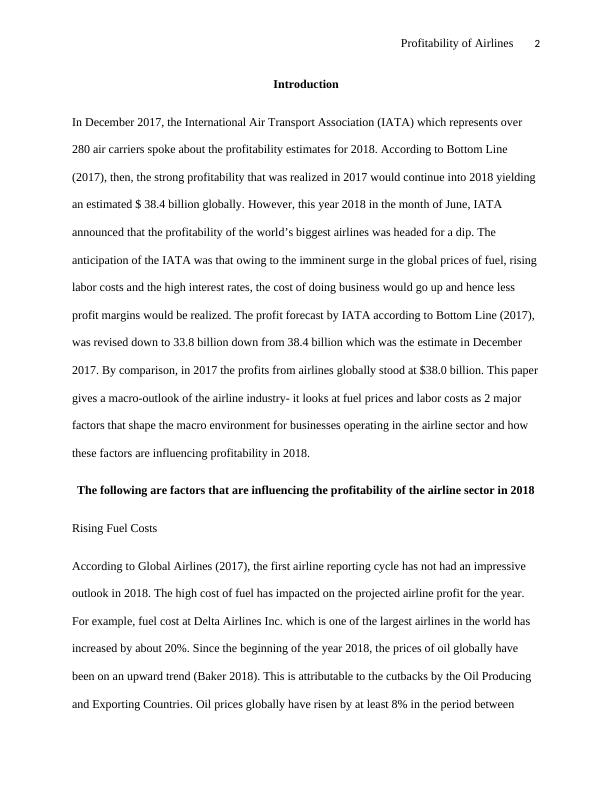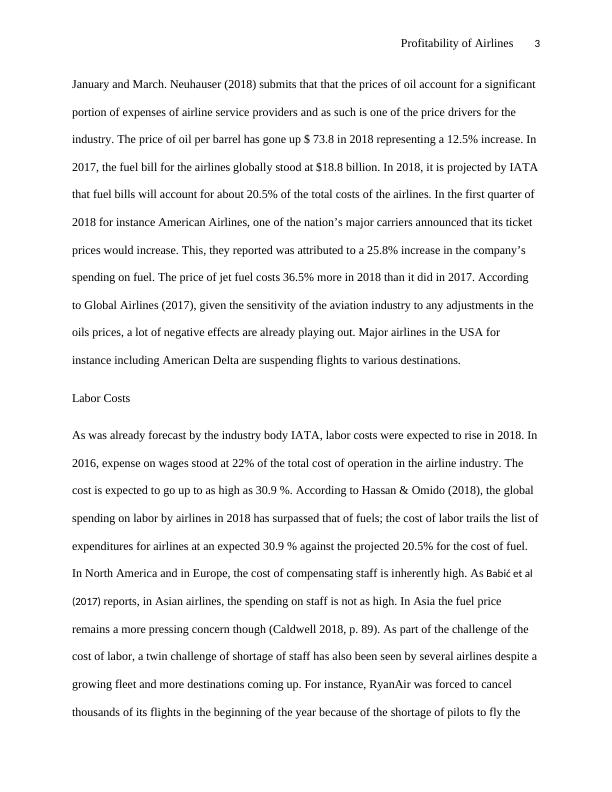Macro-Vision of Profitability in the Airline Industry
Added on 2023-06-03
7 Pages2019 Words184 Views
Profitability of Airlines 1
MACRO-VISION OF PROFITABILITY IN THE AIRLINE INDUSTRY
Name
Institution
Course
Tutor
City/State
Date
MACRO-VISION OF PROFITABILITY IN THE AIRLINE INDUSTRY
Name
Institution
Course
Tutor
City/State
Date

Profitability of Airlines 2
Introduction
In December 2017, the International Air Transport Association (IATA) which represents over
280 air carriers spoke about the profitability estimates for 2018. According to Bottom Line
(2017), then, the strong profitability that was realized in 2017 would continue into 2018 yielding
an estimated $ 38.4 billion globally. However, this year 2018 in the month of June, IATA
announced that the profitability of the world’s biggest airlines was headed for a dip. The
anticipation of the IATA was that owing to the imminent surge in the global prices of fuel, rising
labor costs and the high interest rates, the cost of doing business would go up and hence less
profit margins would be realized. The profit forecast by IATA according to Bottom Line (2017),
was revised down to 33.8 billion down from 38.4 billion which was the estimate in December
2017. By comparison, in 2017 the profits from airlines globally stood at $38.0 billion. This paper
gives a macro-outlook of the airline industry- it looks at fuel prices and labor costs as 2 major
factors that shape the macro environment for businesses operating in the airline sector and how
these factors are influencing profitability in 2018.
The following are factors that are influencing the profitability of the airline sector in 2018
Rising Fuel Costs
According to Global Airlines (2017), the first airline reporting cycle has not had an impressive
outlook in 2018. The high cost of fuel has impacted on the projected airline profit for the year.
For example, fuel cost at Delta Airlines Inc. which is one of the largest airlines in the world has
increased by about 20%. Since the beginning of the year 2018, the prices of oil globally have
been on an upward trend (Baker 2018). This is attributable to the cutbacks by the Oil Producing
and Exporting Countries. Oil prices globally have risen by at least 8% in the period between
Introduction
In December 2017, the International Air Transport Association (IATA) which represents over
280 air carriers spoke about the profitability estimates for 2018. According to Bottom Line
(2017), then, the strong profitability that was realized in 2017 would continue into 2018 yielding
an estimated $ 38.4 billion globally. However, this year 2018 in the month of June, IATA
announced that the profitability of the world’s biggest airlines was headed for a dip. The
anticipation of the IATA was that owing to the imminent surge in the global prices of fuel, rising
labor costs and the high interest rates, the cost of doing business would go up and hence less
profit margins would be realized. The profit forecast by IATA according to Bottom Line (2017),
was revised down to 33.8 billion down from 38.4 billion which was the estimate in December
2017. By comparison, in 2017 the profits from airlines globally stood at $38.0 billion. This paper
gives a macro-outlook of the airline industry- it looks at fuel prices and labor costs as 2 major
factors that shape the macro environment for businesses operating in the airline sector and how
these factors are influencing profitability in 2018.
The following are factors that are influencing the profitability of the airline sector in 2018
Rising Fuel Costs
According to Global Airlines (2017), the first airline reporting cycle has not had an impressive
outlook in 2018. The high cost of fuel has impacted on the projected airline profit for the year.
For example, fuel cost at Delta Airlines Inc. which is one of the largest airlines in the world has
increased by about 20%. Since the beginning of the year 2018, the prices of oil globally have
been on an upward trend (Baker 2018). This is attributable to the cutbacks by the Oil Producing
and Exporting Countries. Oil prices globally have risen by at least 8% in the period between

Profitability of Airlines 3
January and March. Neuhauser (2018) submits that that the prices of oil account for a significant
portion of expenses of airline service providers and as such is one of the price drivers for the
industry. The price of oil per barrel has gone up $ 73.8 in 2018 representing a 12.5% increase. In
2017, the fuel bill for the airlines globally stood at $18.8 billion. In 2018, it is projected by IATA
that fuel bills will account for about 20.5% of the total costs of the airlines. In the first quarter of
2018 for instance American Airlines, one of the nation’s major carriers announced that its ticket
prices would increase. This, they reported was attributed to a 25.8% increase in the company’s
spending on fuel. The price of jet fuel costs 36.5% more in 2018 than it did in 2017. According
to Global Airlines (2017), given the sensitivity of the aviation industry to any adjustments in the
oils prices, a lot of negative effects are already playing out. Major airlines in the USA for
instance including American Delta are suspending flights to various destinations.
Labor Costs
As was already forecast by the industry body IATA, labor costs were expected to rise in 2018. In
2016, expense on wages stood at 22% of the total cost of operation in the airline industry. The
cost is expected to go up to as high as 30.9 %. According to Hassan & Omido (2018), the global
spending on labor by airlines in 2018 has surpassed that of fuels; the cost of labor trails the list of
expenditures for airlines at an expected 30.9 % against the projected 20.5% for the cost of fuel.
In North America and in Europe, the cost of compensating staff is inherently high. As Babić et al
(2017) reports, in Asian airlines, the spending on staff is not as high. In Asia the fuel price
remains a more pressing concern though (Caldwell 2018, p. 89). As part of the challenge of the
cost of labor, a twin challenge of shortage of staff has also been seen by several airlines despite a
growing fleet and more destinations coming up. For instance, RyanAir was forced to cancel
thousands of its flights in the beginning of the year because of the shortage of pilots to fly the
January and March. Neuhauser (2018) submits that that the prices of oil account for a significant
portion of expenses of airline service providers and as such is one of the price drivers for the
industry. The price of oil per barrel has gone up $ 73.8 in 2018 representing a 12.5% increase. In
2017, the fuel bill for the airlines globally stood at $18.8 billion. In 2018, it is projected by IATA
that fuel bills will account for about 20.5% of the total costs of the airlines. In the first quarter of
2018 for instance American Airlines, one of the nation’s major carriers announced that its ticket
prices would increase. This, they reported was attributed to a 25.8% increase in the company’s
spending on fuel. The price of jet fuel costs 36.5% more in 2018 than it did in 2017. According
to Global Airlines (2017), given the sensitivity of the aviation industry to any adjustments in the
oils prices, a lot of negative effects are already playing out. Major airlines in the USA for
instance including American Delta are suspending flights to various destinations.
Labor Costs
As was already forecast by the industry body IATA, labor costs were expected to rise in 2018. In
2016, expense on wages stood at 22% of the total cost of operation in the airline industry. The
cost is expected to go up to as high as 30.9 %. According to Hassan & Omido (2018), the global
spending on labor by airlines in 2018 has surpassed that of fuels; the cost of labor trails the list of
expenditures for airlines at an expected 30.9 % against the projected 20.5% for the cost of fuel.
In North America and in Europe, the cost of compensating staff is inherently high. As Babić et al
(2017) reports, in Asian airlines, the spending on staff is not as high. In Asia the fuel price
remains a more pressing concern though (Caldwell 2018, p. 89). As part of the challenge of the
cost of labor, a twin challenge of shortage of staff has also been seen by several airlines despite a
growing fleet and more destinations coming up. For instance, RyanAir was forced to cancel
thousands of its flights in the beginning of the year because of the shortage of pilots to fly the

End of preview
Want to access all the pages? Upload your documents or become a member.
Related Documents
Determinants of Airlines Profitability: An Analysis of Air Algerialg...
|96
|29850
|53
Financial Analysis of Sydney Airport and Auckland Airport: Industry Overview, Stock Prices, and Ratioslg...
|26
|5114
|184
Principals of Financial Markets Group - Qantas vs Virgin Australialg...
|18
|4015
|239
Global Business Environment Portfolio Paper.lg...
|5
|842
|87
Air Algerie: A Study on Performance and Restructuring Planlg...
|56
|16442
|95
Research Proposal on 'Assessing Challenges of Qantas Airways'lg...
|8
|1448
|20
